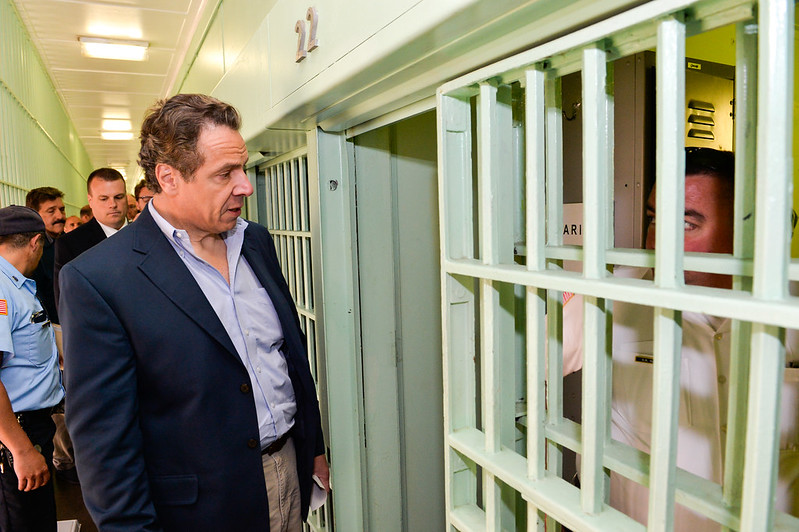
Gov. Cuomo tours a prison (photo: Governor's Office)
At the time of this writing, more than 287 detainees in New York City jails and 441 Department of Correction staff members have tested positive for the new coronavirus, COVID-19. Each of these men and women have friends and family members who wake up every morning, desperately hoping not to receive that dreaded call they know is increasingly possible. And there are thousands more families with loved ones in state prisons who carry that same fear.
The news gets more dire each day. This past week, Michael Tyson, a 53-year-old man, became the first incarcerated person at Rikers Island to die from COVID-19. Just a few days before that, Juan Mosquero died in the infirmary at Sing Sing Correctional Facility—the prison up the river in Ossining. They’re the first tragic coronavirus-related deaths in our state’s jails and prisons, but the data tells us that they won’t be the last.
We know the perilous situation facing thousands of New Yorkers. As two formerly incarcerated individuals, this is personal.
Make no mistake: the standard condition inside correctional facilities is never conducive to health and wellbeing. Prisons and jails are unhealthy environments for all people—whether they work on staff or live there—and amidst a viral pandemic, correctional facilities represent a humanitarian crisis. You can’t perform proper “social distancing” and pandemic personal care in these facilities, where soap and cleaning supplies are rationed, and sanitizer and alcohol products are contraband.
When we were in prison, it was not uncommon to have three or four people held in a small cell, which often included toilet facilities. Meals and recreation were available only in crowded groups.
Which is why, in light of the current situation, it is critically urgent that Governor Cuomo release a comprehensive plan for humanely and properly reducing prison populations across New York. Because while he has taken some key initial steps, he has resisted calls to comprehensively address the looming full-blown crisis in New York’s jails and prisons.
While lowering the populations of New York’s expansive system of locally-operated jails requires buy-in from local governments across the state, the Governor has the sole authority to drastically reduce the state’s prison population today. The Governor could release elderly people, those with chronic conditions, and women who are pregnant and have immune deficiencies. He could introduce a moratorium on incarceration for technical violations of parole and grant early parole to people who are within 180 days of completing their sentences.
These aren’t radical steps. They’re sensible ones. They should have been taken weeks ago; they should be done today.
Other states, including more conservative ones like Ohio and Kentucky, under Republican and Democratic chief executives alike, are taking significant actions to reduce their prison populations. Governors in our neighboring states of New Jersey and Pennsylvania have swiftly implemented solutions to address mass incarceration by removing elderly and ill detainees and those who pose no threat to public safety from facilities into expanded home detention in response to the virus. And for good reason: across America, older adults make up a larger share of state prisons than people 18-24, and there are 150,000 incarcerated people above 55 years old. In San Francisco, the jail population has gone from 1,238 to 766 since the crisis began, and crime rates have plunged.
Astonishingly, Governor Cuomo said more than a week ago that he has no plans to reduce the prison population, almost trying to say it wasn’t possible, even as he sounds repeated alarms for New Yorkers to keep their distance from each other and while a stack of clemency applications for qualified individuals sits on his desk. The Governor can, with the stroke of a pen, choose to release anyone in state custody. He can choose the safety and wellbeing of people in prisons, including corrections officers, and people in the larger community by flattening the curve behind the wall. He can act.
In this global health crisis, we must not condemn people in prison to death through inaction. Hundreds of public health officials and judges have signed letters urging for immediate releases to stem the shocking rise in infections in jails and prisons. We proudly join them to demand that our families, friends, and community members be released, and we stand ready to support people with community services once they are home.
There is still time for Governor Cuomo to flatten the curve behind the wall. As the coronavirus spreads, we can no longer keep it out of our correctional facilities, but we can still take immediate steps to prevent the deaths of thousands of people detained in our jails and prisons, as well as thousands who go to work in them and their family members. And we have the opportunity to emerge from this crisis a more equitable and safe New York.
***
Khalil A. Cumberbatch and Topeka K. Sam are formerly incarcerated New Yorkers who lead New Yorkers United for Justice. On Twitter @KhaCumberbatch & @TopekaKSam & @NYforJustice.
***
Have an op-ed idea or submission for Gotham Gazette? Email This email address is being protected from spambots. You need JavaScript enabled to view it.




